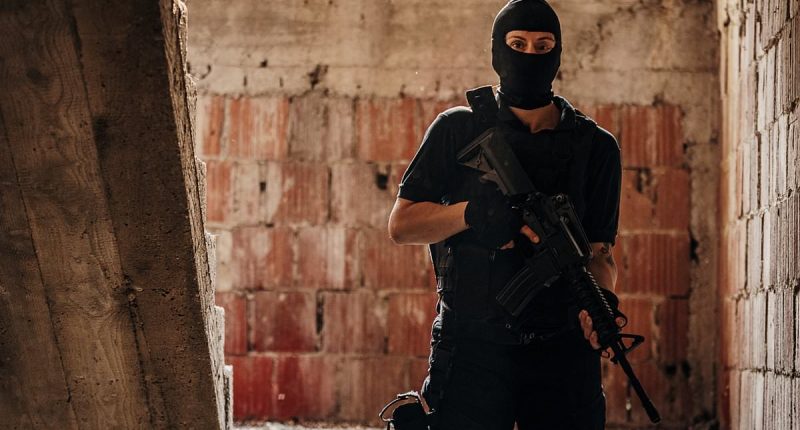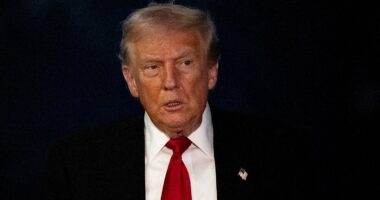Share this @internewscast.com
A shocking wave of Iranian regime insiders — including suspected members of the Islamic Revolutionary Guard Corps (IRGC) — have quietly moved to Canada in recent years, stoking fears of sleeper cells poised to strike targets across North America.
The explosive revelation comes amid heightened tensions in the Middle East, where a shaky ceasefire appears to be holding after America joined Israel’s 12-day bombing campaign of Iran’s nuclear program.
Now, national security experts say Canada’s loose immigration system may have opened the floodgates to Iranian operatives bent on retaliation — and that the threat could extend across the border into the US.
They include a former Canadian minister who claimed Iranian agents seek to ‘target Jews and others abroad’ and an American former FBI chief who uncovered a web of Iran-aligned agents on both sides of the US-Canada border.
Fears came to a head this week when Canadian frontier officials revealed they are investigating or taking enforcement action in 66 cases involving suspected senior Iranian officials who may have been allowed into Canada.
Among those cases are 20 people who have been identified as inadmissible because they are likely senior Iranian officials, according to data that the Canada Border Services Agency (CBSA) provided to the Daily Mail.
One person has so far been removed from Canada for their ties to Tehran. Two others are being deported. Another two were deemed inadmissible, but are appealing that decision, according to figures covering the investigation up to June 6.
Spokesperson Rebecca Purdy said the agency was orchestrating a ‘strong response to suspected senior officials in the Iranian regime’ and will ‘stop them from seeking or finding safe haven in Canada.’

North America has been braced in recent days for an attack by a ‘sleeper cell’ of Middle Eastern commandos

Iranian officials have snuck into Canada using fake IDs and blending in with a diaspora of 400,000, including these regime critics in Toronto
Irwin Cotler, a former Canadian Liberal justice minister, is among those who fear that Tehran has, in recent years, embedded sleeper cell agents in Canada to activate and strike at a time of their choosing.
‘Right now, their policy is to target Jews and others abroad,’ he said of the Iranian government in a recent interview with The Globe and Mail.
‘We also know that they activate sleeper cells that are already present in the country.’
Cotler, a fervent supported of Israel who is on an Iranian hit list, said he fears Tehran may have activated operatives in Canada to carry out acts of violence against opponents of the Iranian government.
‘We don’t want any untoward Iranian penetration at this time,’ added Cotler.
A Canadian government inquiry earlier this year found that Tehran keeps tabs on regime critics among its diaspora in Canada, and that Iranian officials with records of human right violations had snuck into the country using fake identities.
They can easily blend in with Canada’s sizeable population of Iranian origin — some 400,000 people concentrated in big urban centers, particularly in Southern Ontario, British Columbia, and Quebec.
Alarmingly, some are believed to have connections to the IRGC, the regime’s powerful paramilitary force known for orchestrating foreign terror operations, including bombings, assassinations, and cyber warfare.
Some say that the scale of Iranian covert operations in North America is larger and more dangerous than is widely appreciated.
StopIRGC, a voluntary group that investigates tips and monitors social media posts and news articles, says it has identified 91 cases of former Iranian officials living in Canada since it was founded in 2022.
The group’s organizer, Mojdeh Shahriari, an Iranian-Canadian lawyer, has urged the government to work to ‘rid this beautiful, peace-loving country from bad actors including the terrorist members of the IRGC.’
Concern about Iranian activity in Canada extend south of the border, where former FBI chief Chris Swecker has identified a clandestine network of Iran-aligned Hezbollah operating on both sides of the US-Canada border.
Swecker, who was an assistant FBI director in the 2000s, says these agents could activate and strike in the US without any direct orders from Hezbollah’s headquarters in Lebanon or Iran, despite a ceasefire coming into effect.

‘Their policy is to target Jews and others abroad,’ says Canadian Irwin Cotler, former Minister of Justice

The revelations have stoked fears of infiltration, sleeper cells and even terror strikes along the lines of the 9/11 attacks

Former FBI chief Chris Swecker says ‘religious fanatics’ could strike the US even without a green-light from Tehran

Former FBI boss Chris Swecker uncovered a Hezbollah network operating on both sides of the US-Canada border
‘I think there is a clear and present danger and the greatest terrorist threat in the post-9/11 era,’ Swecker told the Daily Mail.
As head of a prosecution effort in North Carolina in the early 2000s, Swecker said he had identified fundraisers and agents of the Lebanese Shiite political party-cum-militia in Michigan, Kentucky and Canada.
Swecker says the US must remain on alert despite the ceasefire because any sleeper cells or radicalized militants could strike even if an attack did not serve the interests of Iran or its proxies.
‘It’s not rational. There’s nothing to be gained by going out and killing Americans, shooting up a shopping mall or a sporting event, or driving a truck through a parade,’ Swecker said.
‘But they’re not rational. They’re religious fanatics, and they wouldn’t necessarily need a direct order from the mothership in Lebanon.’
Swecker’s fears are not without basis — there have been multiple documented cases of nefarious Iranian operations in the US since religious conservatives seized control in the 1979 Islamic Revolution.
A US jury in March convicted two agents of Iran for plotting to assassinate the Iranian-American journalist Masih Alinejad in New York in 2022.
Last November, the US Department of Justice announced charges against an Iranian national and two American accomplices for plotting to assassinate President Donald Trump.
Still, in those plots, Tehran appeared to have hired US-based individuals without any personal ties to Iran to execute their plans — something they would not need to do if they had a network of covert operatives here.
Tricia McLaughlin, assistant secretary to the Department of Homeland Security, said in an email that agents were working ‘full throttle on identifying and arresting known or suspected terrorists and violent extremists that illegally entered this country.’
‘We have been saying we are getting the worst of the worst out — and we are,’ added McLaughlin.
‘We don’t wait until a military operation to execute; we proactively deliver on President Trump’s mandate to secure the homeland.’
Iran’s mission to the United Nations in New York, StopIRGC, and Cotler did not answer our requests for comment.

Iran spent decades arranging an Axis of Resistance to advance its revolutionary goals
The revelations about Iran-aligned agents embedded across North America comes as the US, Israel, and Iran assess the fallout of the 12-day war and to what extent Tehran’s nuclear program had been destroyed.
Trump said his decision to unleash bunker-busting bombs in Sunday’s attack had devastated Iran’s nuclear program and called the outcome ‘a victory for everybody.’
But Iran’s Foreign Minister Abbas Araghchi told state media on Friday that US and Israeli airstrikes caused ‘excessive and serious damage’ to its facilities, and that Trump was ‘exaggerating’ the attack’s success.
He also shut down ‘speculation’ that Tehran would return to negotiations with the United States over its nuclear program, stoking fears that further military confrontations are on the horizon.
‘I would like to state clearly that no agreement, arrangement or conversation has been made to start new negotiations,’ Abbas Araghchi said. ‘No plan has been set yet to start negotiations.’
Against this backdrop, the Daily Mail takes a look at the groups Tehran has used to project power around the world.
The Quds Force
Size: 20,000 (estimated)
Location: Iran, operates globally
Leader: In flux

Islamic Revolutionary Guard Corps armed personnel wear masks and participate in a military rally in downtown Tehran in January

Iran is reeling from devastating Israeli airstrikes, including June 23 hits on Islamic Revolutionary Guard Corps sites in Tehran
At the heart of Tehran’s global war machine is the Quds Force, the elite wing of the IRGC, tasked with foreign operations. It is named after the Arabic word for Jerusalem, and is likened to a spy agency with commando units.
With decades of experience funding, training and arming foreign fighters, the Quds Force is Tehran’s go-to instrument for asymmetric warfare. Analysts say that it is likely coordinating Iran’s response, selecting targets across the region and beyond.
The force built up a network of Arab allies known as the Axis of Resistance, establishing Hezbollah in Lebanon in 1982 and supporting the Palestinian militant Islamist group Hamas in the Gaza Strip.
Quds Force leaders have in recent years plotted to bomb Israeli and Saudi embassies in Washington, and have been involved in assassination plots against Republican hawks John Bolton and Mike Pompeo, along with a Saudi ambassador to the US.
Intelligence chiefs fear that Quds Force already has ‘sleeper’ cells operating in the US homeland. Some 729 Iranian nationals were reportedly allowed into the US between 2021 and 2024 under the Biden administration’s relaxed border rules.
Hamas
Size: 20,000 (estimated)
Location: Palestinian territories
Leader: In flux

Hamas fighters put on a show of force in January 2025, but it’s not clear whether they can stage a serious attack on Israel today
The Palestinian group Hamas, a Sunni militant group focused on a land dispute with Israel, was quick to condemn US strikes on Iran’s nuclear facilities, branding Washington and its regional ally Israel ‘fully responsible for the grave repercussions of this aggression.’
Yet while expressing ‘solidarity’ with Tehran in its official response, Hamas steered clear of that fight, saying it had ‘complete confidence in Iran’s ability to defend its sovereignty and the interests of its people.’
Hamas is not the force it was before the coordinated October 7, 2023, raids on southern Israel that prompted a ferocious reciprocal military onslaught on the militants and blameless Gaza residents alike.
Virtually all of Hamas’ senior leaders have been killed, and it remains unclear whether the group can still mount major attacks on Israel.
Israel says that it has killed some 20,000 militants in Gaza. US officials in January said Hamas had recruited as many as 15,000 fighters since the war began, though many were young and untrained.
Hamas leaders expressed ‘disappointment’ at the lackluster support they received from Axis allies against Israel.
Hezbollah
Size: 50,000 (estimated)
Location: Southern Lebanon
Leader: Naim Qassem

Hezbollah fighters seen in 2002. The group has been torn apart by recent Israeli attacks
Hezbollah was once seen as the ‘crown jewel’ of Iran’s surrogates and the most deadly member of the ‘ring of fire’ to attack Israel in the event of war between the Jewish state and Iran.
But much has changed since Hamas’ October 2023 raids and Israel’s military response in Gaza, and then against Hezbollah in Lebanon, involving everything from airstrikes to exploding pagers.
The group is understood to be well short of the 100,000 fighters it boasted of in 2021. It bears the brunt of regular Israel strikes and commando raids, and has not launched a single attack on Israel since the recent flare-up began.
A spokesperson for Hezbollah told Newsweek that the group did not have immediate plans to retaliate against Israel and the US over their strikes on Iran’s nuclear program, saying Iran was a ‘strong country capable of defending itself.’
‘Logic dictates that it can confront America and Israel.’
Still, US intelligence agencies remain alarmed at Hezbollah’s worldwide footprint of terrorist cells, including militants who could have crossed America’s southern border to launch attacks on American soil.
The Houthis
Size: 10,000 to 30,000
Location: Yemen
Leader: Abdul-Malik al-Houthi

Yemen’s Houthi group followers are a wild card that could be the most likely to join Iran’s fight
The rebel Houthi armed movement in Yemen is the Tehran-aligned group perhaps best positioned to forcefully respond to the US and Israeli airstrikes on Iran.
Since the weekend attacks, the Houthis have vowed to support Iran in its fight and called for Muslim states to join the ‘Jihad and resistance option as one front against the Zionist-American arrogance.’
Yet while the Houthis have a track record of long-range drone strikes on Israel and missile attacks on shipping containers transiting the nearby Red Sea, these do not appear to have resumed amid the current escalation.
The Houthis are still technically bound by a ceasefire they struck with the US in May – Washington stopped its military campaign in exchange for the group halting attacks on US interests in the region.
The Houthis, too, have had their missiles and other military assets in Yemen pounded by Israeli warplanes for months, along with US and British strikes aimed at reducing their threat to shipping in the region.
While the Houthis have received arms and training from Iran over the years, they follow a different branch of Islam, are geographically isolated and chiefly focused on their country’s 11-year civil war.
Syria and Iraq
Sizes: Various groups from 3,000 to 60,000
Location: Syria and Iraq
Leader: Various

Kata’ib Hezbollah members mourn the loss of one of their commanders in an Israeli antistrike in September 2024
In terms of raw manpower, Iran’s proxy strength is perhaps greatest across Iraq and, to a lesser extent, in Syria. Tehran has strong ties to nearly a dozen armed groups there, some with as many as 60,000 fighters.
Among the most formidable are Kata’ib Hezbollah, an Iraqi Shia Islamist paramilitary group founded in 2003 to fight off US-led forces there, and the Badr Organization, which was formed in the years after the 1979 Islamic Revolution.
Kata’ib Hezbollah has a record of attacking US bases at the behest of Iran. Its commander Abu Ali al-Askari has threatened to target US bases over its attack on Iran, telling CNN that they ‘will become akin to duck-hunting grounds.’
Still, these Shiite groups are also focused chiefly on local concerns. Iran in the past wielded great influence in Syria, thanks to President Bashar Al Assad’s growing reliance on Tehran to prop up his embattled government.
Tehran’s influence in Syria collapsed after Assad’s regime fell in December and Sunni rebels seized control of the country. Crucially, this denied Iran a land route to supply missiles to Hezbollah in Lebanon.









